The gas fired construction generator sets market is projected to grow from USD 1.0 billion in 2025 to USD 2.5 billion by 2035, registering a CAGR of 10.0% during the forecast period. Growth is supported by rising infrastructure activities, increasing demand for reliable temporary power solutions at construction sites, and the preference for gas-fired units over diesel due to reduced emissions and lower operating costs.
From 2025 to 2030, the market is expected to see steady adoption driven by urban development projects, government spending on public works, and growing popularity of cleaner fuel alternatives in temporary power generation. Between 2031 and 2035, adoption will accelerate further as hybridized gas generator systems, advanced monitoring technologies, and stricter compliance with environmental regulations reshape market dynamics. Overall, the sector’s expansion will be reinforced by the demand for dependable, cost-efficient, and environmentally compliant energy solutions across diverse construction environments.
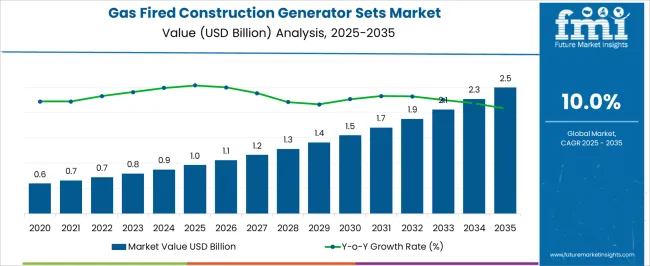
| Metric | Value |
|---|---|
| Gas Fired Construction Generator Sets Market Estimated Value in (2025 E) | USD 1.0 billion |
| Gas Fired Construction Generator Sets Market Forecast Value in (2035 F) | USD 2.5 billion |
| Forecast CAGR (2025 to 2035) | 10.0% |
The gas fired construction generator sets market is progressing steadily due to increasing demand for reliable power backup solutions at construction sites. Industry insights have highlighted a growing need for efficient and cost-effective power generation to support ongoing infrastructure development projects globally. Environmental regulations and a shift towards cleaner energy sources have driven the adoption of gas-fired generators over traditional diesel units.
The ability of gas generators to provide stable and continuous power has made them preferred in applications where equipment uptime is critical. Additionally, rising investments in urbanization and large-scale construction have contributed to the expanded use of portable power solutions.
Advancements in generator technology have improved fuel efficiency and reduced emissions, aligning with sustainability goals. The market outlook remains positive, with segmental growth led by generator sets with power ratings between 50 kVA and 125 kVA, and standby applications representing the largest demand sector.
The gas fired construction generator sets market is segmented by power rating, application, and geographic region. By power rating, the market is divided into ≤ 50 kVA, > 50 kVA – 125 kVA, > 125 kVA – 200 kVA, > 200 kVA – 330 kVA, > 330 kVA – 750 kVA, and > 750 kVA. By application, it is classified into standby, peak shaving, and prime/continuous. Regionally, the gas fired construction generator sets market is categorized into North America, Latin America, Western Europe, Eastern Europe, Balkan & Baltic Countries, Russia & Belarus, Central Asia, East Asia, South Asia & Pacific, and the Middle East & Africa.

The > 50 kVA - 125 kVA power rating segment is projected to hold 35.8% of the gas fired construction generator sets market revenue in 2025, establishing itself as the leading category. This segment’s popularity stems from its ability to provide sufficient power for medium-sized construction sites while maintaining portability and manageable fuel consumption.
Contractors and site managers favor generator sets within this power range for their balance between output capacity and operational efficiency. The modular nature of these generators allows them to be scaled or combined depending on the power requirements of the construction project.
Furthermore, their compatibility with natural gas and other clean fuels aligns with growing environmental regulations, driving preference in this segment. The segment’s growth is further supported by technological advancements that enhance reliability and ease of maintenance.
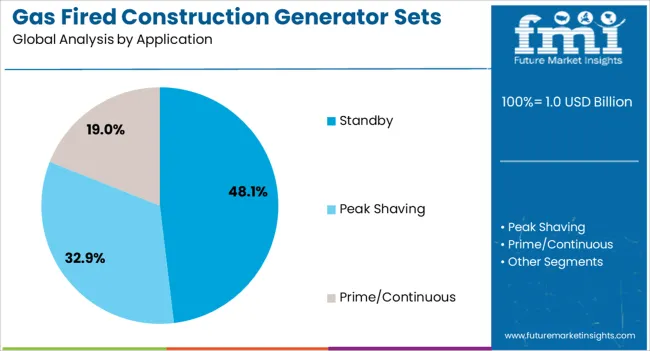
The standby application segment is expected to account for 48.1% of the gas fired construction generator sets market revenue in 2025, retaining its dominant position. This segment benefits from the critical need for backup power to ensure uninterrupted operation during outages or grid failures at construction sites.
Construction projects rely heavily on constant power to maintain equipment functionality, safety systems, and site lighting. Gas fired standby generators provide a cleaner and quieter alternative to diesel backups, making them favorable in urban and regulated environments.
Increased emphasis on site safety and regulatory compliance has pushed the adoption of standby power systems. Additionally, the ability of standby generators to start automatically and deliver power instantly during disruptions adds to their appeal. As construction activity intensifies worldwide the standby application segment is poised to continue leading market demand.
Gas fired construction generator sets are gaining market momentum due to a shift toward cleaner fuel sources, cost efficiency, and operational adaptability. Evolving regulatory frameworks, rental market growth, and technological integration are further shaping their adoption across global construction projects.
Demand for gas fired construction generator sets has been strengthened by the rising number of large-scale infrastructure and commercial building activities worldwide. These generator sets are valued for their ability to provide reliable, continuous power in remote and urban construction sites where grid connectivity is limited. Contractors and project managers prefer gas-fired units over diesel alternatives in regions with abundant natural gas supply due to lower operating costs and reduced emissions. This preference is also influenced by the ability to comply with noise and air quality standards, which are increasingly being enforced in major construction hubs. As megaprojects in transportation, industrial zones, and residential complexes expand, the requirement for dependable on-site power sources is expected to intensify, solidifying the role of these units in the construction power equipment mix.
Stricter environmental regulations and emission norms are encouraging the construction sector to adopt gas-fired generator sets in place of diesel models. Governments in several regions are offering incentives, tax benefits, or relaxed permitting processes for equipment powered by cleaner fuels such as natural gas and LPG. This regulatory push has been particularly impactful in developed economies and fast-growing industrial regions. Contractors are increasingly prioritizing compliance readiness when selecting power generation equipment to avoid penalties or project delays. This trend is also fostering interest in hybrid systems that combine gas-powered units with renewable energy integration, offering better environmental performance without compromising reliability. Such shifts in fuel preferences are expected to maintain upward pressure on demand for gas-fired construction generator sets in the coming years.
The growth of the equipment rental market is playing a key role in expanding the penetration of gas-fired construction generator sets. Many construction firms prefer renting instead of purchasing, as it reduces upfront capital costs and allows for flexibility in project planning. Rental companies are expanding their fleets with gas-powered models to meet rising client demand for fuel-efficient and emission-compliant solutions. Seasonal construction activities, short-term projects, and events requiring temporary infrastructure are major demand drivers for rental-based deployments. These units are also being favored in situations where site-specific requirements mandate quieter operation and lower exhaust emissions. The combination of cost-effectiveness, operational adaptability, and compliance advantages makes gas-fired generator sets an attractive choice for rental fleets serving diverse construction segments.
Advances in engine design, fuel management systems, and control interfaces have improved the reliability and efficiency of gas-fired construction generator sets. Telematics-enabled monitoring allows operators and fleet managers to track performance, schedule maintenance, and detect faults remotely, reducing downtime and extending operational lifespan. Automatic load management systems are being integrated to optimize fuel consumption based on variable power demands at construction sites. Enhanced enclosure designs are improving weather resistance and sound attenuation, making these units suitable for a wide range of environments. These developments are helping manufacturers position their offerings as high-value solutions that meet both operational and regulatory expectations, ultimately strengthening their competitiveness within the global construction power generation segment.

The gas fired construction generator sets market is projected to expand at a global CAGR of 10.0% from 2025 to 2035, supported by the shift toward cleaner fuel sources, the rise in infrastructure spending, and stricter emission regulations. China leads with a CAGR of 13.5%, driven by extensive infrastructure programs, large-scale industrial site developments, and the government’s promotion of natural gas over diesel in construction equipment. India follows at 12.5%, supported by rapid expansion of commercial and residential projects, coupled with cost advantages in natural gas supply. France grows at 10.5%, driven by construction projects in transport, energy, and public facilities. The United Kingdom achieves 9.5% growth, supported by demand from urban redevelopment and large-scale industrial sites. The United States posts a CAGR of 8.5%, reflecting increased adoption in grid-constrained projects and a growing rental market for emission-compliant generator sets. The analysis spans more than 40 countries, with these markets acting as primary benchmarks for capacity planning, regulatory adaptation, and competitive positioning in the global gas fired construction generator sets industry.
China is expected to record a CAGR of 13.5% for 2025–2035, well above the global 10.0%, supported by massive infrastructure investment, stringent air quality regulations, and greater natural gas availability. From 2020–2024, the CAGR was around 8.7% as activity was largely tied to baseline infrastructure expansions and capacity rebuilds after prior slowdowns. The significant rise stems from broader adoption of gas-fired solutions over diesel in urban and industrial projects, bolstered by cost benefits in regions with pipeline access. High-speed rail expansion, industrial park construction, and integrated port facilities are increasing demand for reliable, emission-compliant power solutions. Manufacturers are enhancing telematics integration, automated load management, and weatherproof enclosures to meet diverse site requirements.
India is projected to achieve a CAGR of 12.5% during 2025–2035, above the global average of 10.0%, driven by rapid infrastructure rollout, industrial corridor development, and competitive gas pricing. Between 2020–2024, CAGR was approximately 7.9%, as adoption was limited to high-value projects and selective industrial deployments. The surge in growth is linked to wider penetration in commercial real estate, metro rail projects, and manufacturing clusters requiring cost-effective backup and prime power solutions. Adoption is also being shaped by rental fleet expansion in metro and tier-2 cities. Vendors are localizing assembly, improving service networks, and offering remote monitoring to boost reliability and reduce operational downtime.
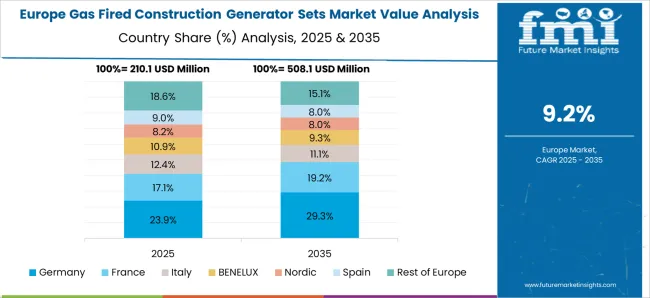
France is forecast to post a CAGR of 10.5% for 2025–2035, just above the global 10.0%, driven by infrastructure renewal programs, stricter emission compliance, and increasing reliance on gas-fired units in city-center projects. During 2020–2024, CAGR stood at about 6.8%, when market expansion was constrained by moderate project starts and high diesel market dominance. The improvement reflects policy-led transitions to cleaner energy sources and integration of gas-powered units in transport hubs, healthcare facilities under construction, and renewable-linked hybrid sites. Manufacturers are introducing quieter, low-emission designs suited for dense urban areas and projects with strict noise regulations.
The United Kingdom is expected to register a CAGR of 9.5% during 2025–2035, slightly below the global 10.0%, supported by urban redevelopment, industrial site refurbishments, and growing rental fleet deployment. From 2020–2024, CAGR was near 5.9%, with growth driven primarily by selective adoption in projects requiring noise- and emission-compliant solutions. The increase in CAGR is attributed to wider replacement of diesel units in compliance with clean air initiatives, combined with higher uptake in rail and port modernization projects. Expansion of LNG supply chains and rental operator investment in advanced telematics-equipped units are supporting greater operational efficiency.
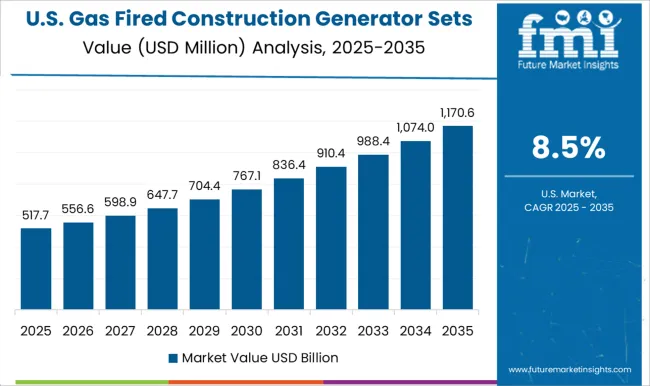
The United States is projected to post a CAGR of 8.5% between 2025–2035, slightly below the global 10.0%, influenced by construction in grid-restricted regions, public works programs, and disaster recovery projects. During 2020–2024, CAGR was roughly 5.4%, with steady demand from industrial projects and emergency preparedness contracts. The improvement is driven by replacement cycles in municipal fleets, rising natural gas availability, and wider deployment in remote oil and gas construction sites. Manufacturers are focusing on load-optimized control systems, hybrid readiness, and extended service intervals to attract both rental and purchase customers.
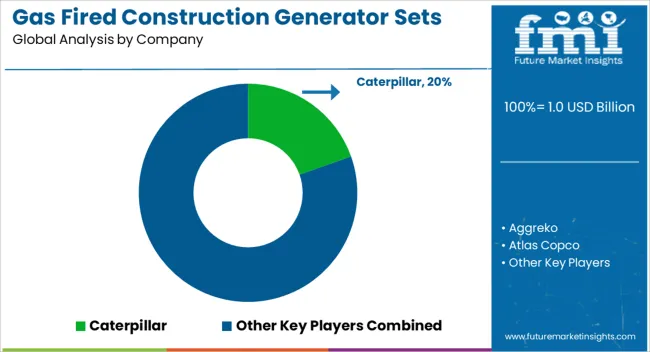
Caterpillar remains a dominant player with a diverse lineup of high-capacity gas-fired units, focusing on advanced control systems, telematics, and ruggedized enclosures for challenging site conditions. Aggreko commands a strong position in the rental segment, offering flexible, short-term power solutions supported by extensive service networks. Atlas Copco integrates generator sets into broader site power and compressor packages, targeting large-scale industrial and infrastructure projects.
Generac Power Systems focuses on portable and mid-range units with emphasis on low-emission designs for regulated environments. Greaves Cotton supplies localized solutions with robust aftersales support, addressing both purchase and rental markets.
HIMOINSA provides containerized gas generator systems with high transportability and ease of deployment. J C Bamford Excavators leverages its construction equipment portfolio to offer integrated power solutions for on-site needs.
Rehlko serves niche construction segments with customized configurations, while Sterling Generators provides turnkey project-based installations. Wartsila focuses on heavy-duty, multi-megawatt installations, integrating gas engines with advanced monitoring for reliability.
| Item | Value |
|---|---|
| Quantitative Units | USD Billion |
| Power Rating | > 50 kVA - 125 kVA, ≤ 50 kVA, > 125 kVA - 200 kVA, > 200 kVA - 330 kVA, > 330 kVA - 750 kVA, and > 750 kVA |
| Application | Standby, Peak Shaving, and Prime/Continuous |
| Regions Covered | North America, Europe, Asia-Pacific, Latin America, Middle East & Africa |
| Country Covered | United States, Canada, Germany, France, United Kingdom, China, Japan, India, Brazil, South Africa |
| Key Companies Profiled | Caterpillar, Aggreko, Atlas Copco, Cooper, Cummins, Generac Power Systems, Greaves Cotton, HIMOINSA, J C Bamford Excavators, Kirloskar, Mahindra Powerol, Mitsubishi Heavy Industries, Rehlko, Sterling Generators, and Wartsila |
| Additional Attributes | Dollar sales, share, regional demand trends, competitor strategies, regulatory impacts, rental fleet adoption rates, fuel cost analysis, and growth opportunities in key construction segments. |
The global gas fired construction generator sets market is estimated to be valued at USD 1.0 billion in 2025.
The market size for the gas fired construction generator sets market is projected to reach USD 2.5 billion by 2035.
The gas fired construction generator sets market is expected to grow at a 10.0% CAGR between 2025 and 2035.
The key product types in gas fired construction generator sets market are > 50 kva - 125 kva, ≤ 50 kva, > 125 kva - 200 kva, > 200 kva - 330 kva, > 330 kva - 750 kva and > 750 kva.
In terms of application, standby segment to command 48.1% share in the gas fired construction generator sets market in 2025.






Our Research Products

The "Full Research Suite" delivers actionable market intel, deep dives on markets or technologies, so clients act faster, cut risk, and unlock growth.

The Leaderboard benchmarks and ranks top vendors, classifying them as Established Leaders, Leading Challengers, or Disruptors & Challengers.

Locates where complements amplify value and substitutes erode it, forecasting net impact by horizon

We deliver granular, decision-grade intel: market sizing, 5-year forecasts, pricing, adoption, usage, revenue, and operational KPIs—plus competitor tracking, regulation, and value chains—across 60 countries broadly.

Spot the shifts before they hit your P&L. We track inflection points, adoption curves, pricing moves, and ecosystem plays to show where demand is heading, why it is changing, and what to do next across high-growth markets and disruptive tech

Real-time reads of user behavior. We track shifting priorities, perceptions of today’s and next-gen services, and provider experience, then pace how fast tech moves from trial to adoption, blending buyer, consumer, and channel inputs with social signals (#WhySwitch, #UX).

Partner with our analyst team to build a custom report designed around your business priorities. From analysing market trends to assessing competitors or crafting bespoke datasets, we tailor insights to your needs.
Supplier Intelligence
Discovery & Profiling
Capacity & Footprint
Performance & Risk
Compliance & Governance
Commercial Readiness
Who Supplies Whom
Scorecards & Shortlists
Playbooks & Docs
Category Intelligence
Definition & Scope
Demand & Use Cases
Cost Drivers
Market Structure
Supply Chain Map
Trade & Policy
Operating Norms
Deliverables
Buyer Intelligence
Account Basics
Spend & Scope
Procurement Model
Vendor Requirements
Terms & Policies
Entry Strategy
Pain Points & Triggers
Outputs
Pricing Analysis
Benchmarks
Trends
Should-Cost
Indexation
Landed Cost
Commercial Terms
Deliverables
Brand Analysis
Positioning & Value Prop
Share & Presence
Customer Evidence
Go-to-Market
Digital & Reputation
Compliance & Trust
KPIs & Gaps
Outputs
Full Research Suite comprises of:
Market outlook & trends analysis
Interviews & case studies
Strategic recommendations
Vendor profiles & capabilities analysis
5-year forecasts
8 regions and 60+ country-level data splits
Market segment data splits
12 months of continuous data updates
DELIVERED AS:
PDF EXCEL ONLINE
Diesel-Fired Construction Generator Sets Market Size and Share Forecast Outlook 2025 to 2035
Gas Generator Sets Market Growth - Trends & Forecast 2025 to 2035
Gas Fired Real Estate Generator Market Size and Share Forecast Outlook 2025 to 2035
Construction Generator Sets Market Size and Share Forecast Outlook 2025 to 2035
Standby Construction Generator Sets Market Size and Share Forecast Outlook 2025 to 2035
Peak Shaving Construction Generator Sets Market Size and Share Forecast Outlook 2025 to 2035
Gas Fired Water-Tube Food Processing Boiler Market Size and Share Forecast Outlook 2025 to 2035
Gas Fired Condensing Low Temperature Commercial Boiler Market Size and Share Forecast Outlook 2025 to 2035
Gas Fired Water Tube Chemical Boiler Market Size and Share Forecast Outlook 2025 to 2035
Gas Fired Boiler Market Size and Share Forecast Outlook 2025 to 2035
Gas Fired Low Temperature Commercial Boiler Market Size and Share Forecast Outlook 2025 to 2035
Gas Fired Commercial Hot Water Boiler Market Size and Share Forecast Outlook 2025 to 2035
Gas Fired Chemical Boiler Market Size and Share Forecast Outlook 2025 to 2035
Gasoline Generator Market - Growth & Demand 2025 to 2035
Generator Sets Market Size and Share Forecast Outlook 2025 to 2035
Gasoline Gensets Market Size and Share Forecast Outlook 2025 to 2035
Gas Telecom Generator Market Size and Share Forecast Outlook 2025 to 2035
Construction Portable Generators Market Size and Share Forecast Outlook 2025 to 2035
Hybrid Generator Sets Market Size and Share Forecast Outlook 2025 to 2035
Construction Prime Power Generators Market Size and Share Forecast Outlook 2025 to 2035

Thank you!
You will receive an email from our Business Development Manager. Please be sure to check your SPAM/JUNK folder too.
Chat With
MaRIA